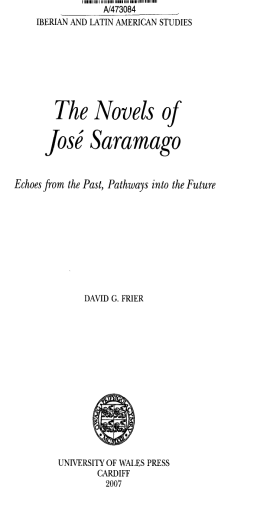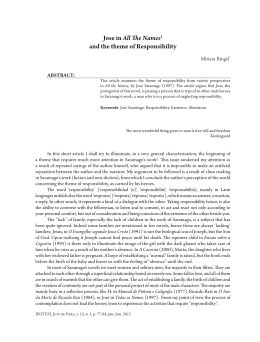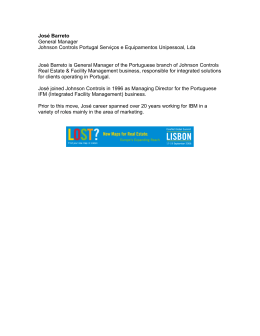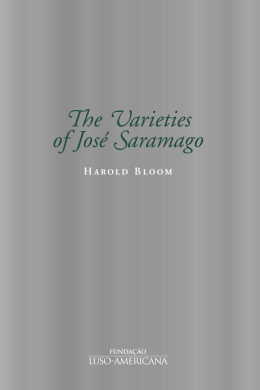"In one sense it could even be said that, letter-by-letter, word-by-word, page-by-page, book after book, I have been successively implanting in the man I was the characters I created. I believe that without them I wouldn't be the person I am today; without them maybe my life wouldn't have succeeded in becoming more than an inexact sketch, a promise that like so many others remained only a promise, the existence of someone who maybe might have been but in the end could not manage to be." Nobel Lecture, 1998 José Saramago (1922-2010) 1 Biography José Saramago was born in Azinhaga in the province of Ribatejo, the son of José de Sousa, an artilleryman in the first world war, and Maria de Piedade. When Saramago was two, the family moved to Lisbon. Saramago's father took a job as traffic policeman and his mother worked as a domestic cleaner. During school holidays, he returned to Azinhaga, where his grandparents, illiterate peasants, lived and took care of him. At an early age, Saramago was forced to abandon school in order to earn his living. Saramago was educated as a technician, and before becoming a journalist, translator, and writer, he did a number of manual jobs. In 1944 Saramago married Ilda Reis, then a typist with the Railway Company, who was to become a respected engraver. Their marriage ended in divorce in 1970. In 1969 Saramago joined the Communist Party of Portugal, which was forbidden during the military dictatorship. In 1975 he lost his job as deputy editor of the Lisbon newspaper Diário de Noticias. “Being fired was the best luck of my life,” he later said in an interview. “It was the birth of my life as a writer.” Since 1979 he devoted himself entirely to writing. In 1988 Saramago married Pilar del Río, a journalist. After government officials banned his novel O EVANGELHO SEGUNDO JESUS CHRISTO (1991, The Gospel According to Jesus Christ), Saramago left Portugal and settled in the Spanish island of Lanzarote. Saramago died after a long illness at his home on 18 June 2010. 2 Bibliography Saramago published plays, short stories, novels, poems, libretti, diaries, and travelogues. His first novel, MANUAL DE PINTURA E CALIGRAFIA, appeared in 1977. Its basic theme is the genesis of the artist, of a painter as well as a writer. In VIAGEM A PORTUGAL (1981, Journey to Portugal) Saramago searched for the idea of Portugal, a few years after the dictatorship had ended. To see his country with fresh eyes and fresh wonder, Saramago used the third person, observing as much his surrounding as his own reactions: "Here he is forced to recognise his own shortcomings, and admit he has everything to learn. About miracles, as all else." LEVANTADO DO CHÃO (1980) was a three-generation saga of a poor sharecropper family from the post-World War I period through to the 25th April 1974, the date of the Portuguese revolution. The story is presented through mixed forms of monologue and dialogue. In the 1980s he gained an international reputation with his satirical novel MEMORIAL DO CONVENTO. The novel is set in the first half of the 18th century. The Italian composer Corghi based his opera Blimunda on the novel. O ANO DA MORTE DE RICARDO REIS (1984) takes its subject from the history in the form of a dialogue between the great Portuguese poet Fernando Pessoa (1888-1935), and his alternative authorial personality from the poetry collection Odes de Ricardo Reis (1946). 3 The story is set in the 1930s, the year of the onset of the Spanish Civil War, and the rise of Hitler, Mussolini, Franco, and Salazar. Truth and lies are inseparable from each other, in fiction and in real life: "A word lies, with the same word one can speak the truth, we are not what we say, we are true only if others believe us." Symbolically, A JANGADA DE PEDRA (1986) tells a story of Iberia’s exclusion from Europe: a series of supernatural events culminates in the severance of the Iberian peninsula so that it starts to float into the Atlantic, initially heading for the Azores. Saramago's tone is ironic -- he mixes different views from the Prime Minister and the US president to tourist officers and European Community. A group of people tries to find an explanation for the phenomenon, among them Joaquim Sassa, who threw a stone in the sea. In 2007 Saramago outraged his compatriots with his statement that it is inevitable that Portugal will end up joining Spain. Saramago's controversial novel, EVANGELHO SEGUNDO JESUS CRISTO, was excluded from the European Union literary contest Ariosto by Sousa Lara, Under-Secretary of State of Portugal, but after international protest it was returned to the list of candidates. Like Nikos Kazantzákis in his novel The Last Temptations of Christ, or Norman Mailer in The Gospel According to the Son, he interprets the key episodes from the Gospels from an ironic point of view, inventing new miracles and prophesies. In the novel God and the Devil negotiate over evil, and Jesus questions his role and challenges God. 4 All this Saramago paralleles with the creative process of a writer: "The gaping mouth sends up a cry we shall never hear, for none of these things is real, what we are contemplating is mere paper and ink, nothing more." Maria Magdalene is a prostitute to whom Jesus gives his virginity. Joseph's feelings of guilt lead to his crucifixion. Jesus takes him down from the cross, helped by Maria. He repeats his father's fate and realizes in his last moments, that his sacrificial death had been planned in advance. " ... the human heart is never content, and that doing one's duty does not bring peace of mind, though those who are easily satisfied would have us believe otherwise." Among Saramago's other later novels is TODOS OS NOMES (1995), in which he pays homage to the bureaucratic labyrinths of Kafka. It depicts a minor official, Senhor José, in a dismal registrar's office, who becomes obsessed with one of the names, an unknown woman, and begins to track her down. But instead of order, he finds chaos. In ENSAIO SOBRE A CEGUEIRA: a novel (1995) an epidemic of blindness starts to spread in a nameless city. An asylum or a concentration camp is founded to isolate the blind who see only white light. A doctor's wife follows her husband to the asylum, and soon around them forms a small group of people who try to maintain some moral values among the internees, when violence starts to escalate. "... blindness is the good fortune of the ugly," Saramago wrote; actually the blind cannot see the ugliness of the world. 5 "Absurd to say it, but the blindness in Saramago's novel is an allegory for not being able to see. What exactly it is we should see, what Saramago -- with all his years as a man and a writer and having lived through dictatorship and revolution -- fears we cannot see, is present in the writing, present abundantly, but it is not to be paraphrased." (Andrew Miller in the New York Times, October 4, 1998) A CAVERNA (2000) is a story of a potter and his family, who are the "real" people, living the life of Plato's famous allegory of the cave. O HOMEM DUPLICADO (2002) played with an old literary cliché, the idea of a doppelganger. Saramago's protagonist, a schoolteacher, asks the existential question, which is the original and which the copy? One of them must die. ENSAIO SOBRE A LUCIDEZ (2006, Seeing), a political satire, was set in the same nameless capital city that Blindness, where a state of emergency is declared after voters cast blank votes in an election. 6 Selected works: OS POEMAS POSSÍVEIS, 1966 (poems) PROVÀVELMENTE ALEGRIA, 1970 DESTE MUNDO E DO OUTRO, 1971 A BAGAGEM DO VIAJANTE, 1973 AS OPINIÕES QUE O DL TEVE, 1974 O ANO DE 1993, 1975 MANUALDE PINTURA E CALIGRAFIA, 1977 - Manual of Painting and Calligraphy OBJECTO QUASE, 1978 POÉTICA DOS CINCO SENTIDOS. O OUVIDO, 1979 A NOITE, 1979 LEVANTADO DO CHÃO, 1980 QUE FAREI COM ESTE LIVRO? 1980 VIAGEM A PORTUGAL, 1981 - Journey to Portugal. In Pursuit of Portugal's History and Culture, 2001 MEMORIAL DO CONVENTO, 1982 - Baltasar and Blimunda. basis for three-act opera by Italian composer Azio Corghi O ANO DA MORTE DE RICARDO REIS, 1984 - The Year of the Death of Ricardo Reis 7 A JAGANDA DE PEDRA, 1986 - The Stone Raft . Film 2002, dir. by George Sluizer, starring Ana Padrao, Gabino Diego, Iciar Bollain, Diogo Infante, HISTORIA DO CERCO DE LISBOA, 1989 - The History of the Siege of Lisbon) O EVANGELHO SEGUNDO JESUS CRISTO, 1991 - The Gospel According to Jesus Christ IN NOMINE DEI, 1993 ENSAIO SOBRE A CEGUEIRA, 1995 – Blindness. Film version 2008, dir. by Fernando Meirelles, starring Julianne Moore, Mark Ruffalo, Gael Garcia Bernal, Danny Glover, Sandra Oh TODOS OS NOMES, 1997 - All the Names EL AMOR POSIBLE, 1998 CADERNOS DE LANZAROTE, 1998 O CONTO DA ILHA DESCONHECIDA, 1988 - The Tale of the Unknown Island A CAVERNA, 2000 - The Cave O HOMEN DUPLICADO, 2002 - The Double ENSAIO SOBRE A LUCIDEZ, 2004 - Seeing AS INTERMITÊNCIAS DA MORTE, 2005 - Death with Interruptions AS PEQUENAS MEMÓRIAS, 2006 - Little Memories A VIAGEM DO ELEFANTE, 2008 - The Elephant's Journey O CADERNO, 2009 - The Notebook 8 Renato Alcobia 12.º7 9 Passado, Presente, Futuro Eu fui. Mas o que fui já me não lembra: Mil camadas de pó disfarçam, véus, Estes quarenta rostos desiguais. Tão marcados de tempo e macaréus. Eu sou. Mas o que sou tão pouco é: Rã fugida do charco, que saltou, E no salto que deu, quanto podia, O ar dum outro mundo a rebentou. Falta ver, se é que falta, o que serei: Um rosto recomposto antes do fim, Um canto de batráquio, mesmo rouco, Uma vida que corra assim-assim. José Saramago, in Os Poemas Possíveis (1966) 10 André Moreira 12.º7 11 Wellington Vinicius 12.º7 12 Rita Alvarez 12.º7 13 Mafalda Jesus 12.º7 14 Thamara da Costa 12.º7 15
Download









